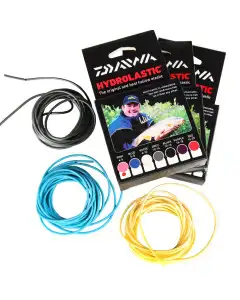This is a demo store. No orders will be fulfilled.
Save Time & Money: Fishing Pole Elastication Service

Regarding pole elastics for fishing, we understand that the array of bungs and puller kits can be overwhelming. But fear not, we have just the solution to make things crystal clear for you.
Angling Direct is thrilled to announce a new in-store service that will help your match angling. We are proud to introduce the Pole Elastication service, available at all our fishing tackle shops across the UK. This service aims to provide convenience at a low cost. It also aims to ensure that your new fishing pole is ready to use right out of the tackle shop.
Do You Need Elastic on a Fishing Pole?
Pole elastic is a versatile tool in match and coarse fishing. Designed to provide anglers with flexibility in hooking fish, elastic for fishing poles can vary based on its rating, type, and fishing techniques.
Some anglers prefer doubling up strands for added strength, while others adjust ratings according to their preferences. Remember to factor in the season and the specific fish species you're targeting. This will help when choosing the ideal pole elastic for your needs.
Why Should I Get My Pole Elasticated?
Opting for the Pole Elastication service offers numerous benefits for anglers:
- Ready-to-use pole: Say goodbye to the hassle of elasticating your new pole yourself. Our service ensures that your pole is immediately ready for action, saving you time and effort.
- Cost-effective solution: With our competitive pricing, you can enjoy the convenience of professional elastication without breaking the bank.
- Expert fitting: Our experienced technicians ensure a precise and secure fitting, giving you peace of mind during your angling sessions.
How do you tie elastic to a fishing pole?
When you bring in your new pole, our knowledgeable Pole Specialists will guide you through the simple process of Pole Elastication. Here's how it works:
1. Select your preferred elastic option from our range.
2. Our skilled technicians will expertly fit the elastic to your top kits, ensuring a secure and reliable setup.
3. We will then attach the elastic to the winder bung using a secure knot or loop.
4. Slide the winder bung into the pole section, ensuring it is snug.
5. Push the elastic through the PTFE bush at the end of the pole section.
6. Stretch the elastic and secure it to the pole using thread or dental floss. Make several tight turns around the pole section.
7. Trim off any excess elastic to complete the process.
If you elasticate your pole with Angling Direct, for the first 5 top kits, the service is available at just £5 each. If you have 6 or more top kits, the cost reduces to an unbeatable £3 per kit.
What are the different types of pole elastic?
We understand that some anglers prefer to choose their own elastic. That's why we offer the option for customers to purchase their own elastic and have our team fit it to their top kits.
Our friendly staff will guide you through the available elastic options, helping you find the perfect fit for your angling needs.
- Solid Elastic: Light and heavy solid elastics offer affordable options but may have a shorter lifespan compared to pricier hollow elastics.
- Light Solid Elastic: Rated between No3 and No8, it's great for smaller fish like roach and skimmers in natural waters. Today, you can find ratings more than double the old No8 standard.
- Heavy Solid Elastic: Rated between No8 and No20, it quickly provides extra power for larger fish such as carp and chub. Ideal for fishing in snag-filled areas, like when targeting chub or big carp in canals.
- Hollow Elastic: Hollow elastic provides more stretch and a softer feel compared to solid elastic. It offers a wider range of ratings, covering various fishing scenarios. Additionally, it tends to be of better quality and durability.
- Light Hollow Elastic: Rated 1-5, perfect for mixed fish. It's highly stretchy, allowing you to land small fish while still having a chance with larger ones.
- Medium Hollow Elastic: Rated 6-12, ideal for general commercial fishing targeting F1s and carp.
- Large Hollow Elastic: Rated 12 and above, designed to handle big fish. It's great for edge fishing on commercial venues and for rivers when going after chub and barbel. This elastic's impressive stretch quickly saps the power of larger fish.
What is hybrid pole elastic?
Another type of pole elastic is hybrid elastic. Hybrid pole elastic combines the best qualities of both solid and hollow elastics. It has a solid construction but offers stretch, like a hollow elastic while providing the power of a solid one.
This versatile elastic is suitable for various fishing scenarios, accommodating anything from small silverfish to large carp, especially when using puller kits.
Maximize your angling potential with the right pole elastic. Explore our extensive range, curated to cater to different fishing styles and conditions. Elevate your fishing experience with Angling Direct, where quality and precision meet to enhance your success on the water.
How Often Do You Change Pole Elastic?
The frequency of changing pole elastic depends on factors like fishing type, elastic condition, and frequency of use. Some anglers replace it every season, while others wait for signs of wear like reduced elasticity or damage. Regular inspection and replacement when needed ensure optimal fishing performance.
If you're experiencing issues with the pole elastic and it is affecting your fishing performance, it is best to replace the elastic promptly.
Ultimately, the frequency of changing pole elasticity can vary depending on individual preferences and fishing conditions. It's good practice to keep an eye on the state of your elastic. Replace it as needed to ensure optimal fishing performance.
How to Store Pole Elastic
Winder Bungs are perfect for small sizes of light, solid elastic. They allow you to store elastic on the winder section. This unique feature enables you to easily adjust the tension, either loosening or strengthening it according to your needs.
Additionally, when the elastic near the connector end begins to wear out, you have the convenience of cutting off the worn portion. Then, simply unwind from the winder and re-tension it accurately for optimal performance. Winder Bungs provide a practical solution to keep your elastic in top condition, ensuring consistent results on the water.
The Pole Elastication service makes your angling journey more enjoyable and hassle-free, just like our popular Spooling service. Simply bring in your new pole, select the elastic option, and let us handle the rest.
At Angling Direct, we are committed to enhancing your angling experience by providing top-notch services that meet your needs. The introduction of the Pole Elastication service at our fishing tackle shops across the UK is a testament to this commitment.
Take advantage of the convenience and cost-effectiveness of our Pole Elastication service. Visit your nearest Angling Direct fishing tackle shop today and let our experts take care of your pole, ensuring it's ready to perform at its best. Get ready to elevate your angling game with our professional Pole Elastication service!


FAQs about Elasticating a Fishing Pole
What do I need to elasticate a fishing pole?
To elasticate a fishing pole, you will need a few essential items: a fishing pole, pole elastic (hollow or solid), a winder bung, PTFE bush, and some thread or dental floss for tying the elastic.
How do you elasticate a fishing whip?
Elasticating a fishing whip is similar to elasticating a fishing pole. Here's a general process:
1. Remove the existing tip from the whip and slide on a PTFE bush.
2. Securely attach the pole elastic by threading it through the PTFE bush.
3. Stretch the elastic and tie it to the whip, using thread or dental floss to make tight turns and secure it in place.
4. Trim off any excess elastic and reattach the whip tip.
How many sections of the pole do you elasticate?
The number of pole sections you should elasticate depends on your fishing preferences and your type of fishing.
Typically, anglers choose to elasticate the top two or three sections of the pole, as these are the areas that experience the most stress when landing fish.
How do you tension an elastic pole?
To tension an elastic pole, follow these steps:
1. Choose the appropriate strength of elastic for your target fish species.
2. Attach the pole elastic to the winder bung.
3. Thread the elastic through the PTFE bush and secure it to the pole.
4. Adjust the tension by stretching the elastic and tying it off at the desired length.
5. Test the tension by pulling the elastic to ensure it provides the desired resistance and control.
What is the best elastic for pole fishing?
The best elastic for pole fishing can vary depending on factors such as the fish species targeted and fishing conditions.
Popular choices include hollow elastics like Slip or Pulla Bungs, which provide excellent stretch and control. Solid elastics, such as solid latex or hybrid elastics, offer more power and are suitable for larger fish. The ideal choice ultimately depends on individual preferences and fishing circumstances.









